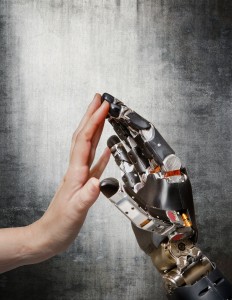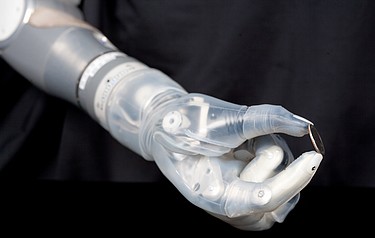Prosthetic Limb Restores Amputees’ Sense of Touch


Thanks to ongoing neurological research at the Revolutionizing Prosthetics department at DARPA (Defense Advanced Research Projects Agency), we are seeing incredible breakthroughs in the advancement of prosthetic limbs. The latest development enables amputees to not only control their robotic limbs with their minds, but to feel with them, too.
Limbs Need to Communicate
Prosthetic limbs have two jobs: to transmit information from a person’s brain to an object (e.g., “Grab the object from the table”), and to transmit information from an object to a person’s brain (e.g., “You now have the object in your hand”). Justin Sanchez, program manager at DARPA, says “Without feedback from signals traveling back to the brain, it can be difficult to achieve the level of control needed to perform precise movements.”
Anatomy of DARPA’s New Robotic Limb
Scientists have long been able to create limbs that can be controlled by a person’s brain; communicating data back up to the brain has been a bit more difficult. To enable both lanes of communication, Sanchez and his team placed electrodes on various parts of one patient’s brain; specifically, the parts responsible for recognizing sensations like pressure and for controlling body movement. They then connected those electrodes to the patient’s mechanical hand.
The hand DARPA used, developed by the Applied Physics Laboratory (APL) at Johns Hopkins University, included state-of-the-art technology that sent electronic signals to the brain when the person touched an object with his prosthetic hand. As part of their study, the research team blindfolded the patient and touched individual fingers on his hand at random; the patient was able to identify which finger they were touching nearly 100% of the time. When researchers touched two fingers at once, he laughed and asked if they were playing a trick on him. At that point, it became clear how well the hand was actually working.
 Room for Growth: The Future of Prosthetic Technology
Room for Growth: The Future of Prosthetic Technology
DARPA’s technology, which essentially builds a network between a person’s brain, their prosthetic limb, and an object, opens up a number of doors for the future. DARPA is presently working on the paper that will document the details of their findings; after peer review and publication, other researches will be able to use it to modify the direction of their own studies.
While the DARPA hand is a huge leap in upper-limb prosthetics, there still is room for improvement. Its movement is still more robotic and jumpy; there’s a lot of work to do before we can say we’ve truly recreated the versatility and maneuverability of the human hand. Some have asked about the possibility of adding temperature sensors and focused, nerve-to-nerve sensitivity. Aesthetics has also been a concern for those developing prosthetics; Open Bionics has even created prosthetics for children that resemble arms of characters in Star Wars, Frozen, and The Avengers. The New York Times recently released this remarkable story of bionic limbs (developed at the same lab that developed the DARPA hand) that have 26 joints and can curl up to 45 pounds.
Of course, one of the biggest issues here is cost. The limb discussed by the Times currently fetches about $500,000—far beyond what most people can afford. Developers hope to reduce the cost of the limbs without sacrificing too much of their performance.
Communicate With Prototyping Engineer!
We’ll keep you posted as updates that come our way. Aside from temperature-detection, acutely focused sensors, and cost reduction, what other developments would you like to see in prosthetics? Post any suggestions below. Our team would love to chat with you.

